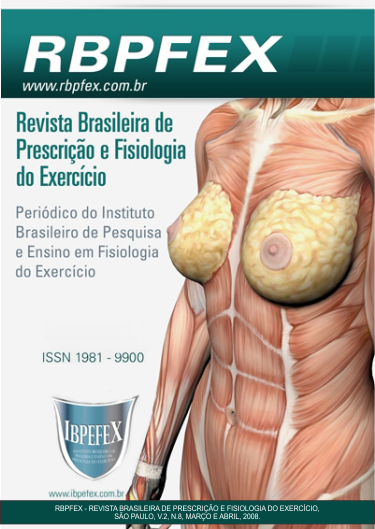Weekly frequency effect of AIT on the aerobic power of recently incorporated military on the Brazilian Army
Abstract
This study’s goal has been to verify the weekly frequency effect of AIT on the aerobic power of recently incorporated military on the Brazilian Army. 80 military, from the 9º Armored Regiment of Cavalry, have participated of the study, all voluntary, masculine sex, age 18.13 years, body mass 67.39 kg and stature 1.73 m, residents in the city of São Gabriel. All participants have made a pre-test, which consisted of the 12 minute test. The group was divided randomly, in four study groups, of which three had carried through the AIT in the weekly three frequencies, two and one days and the other composed the group has controlled, that it did not carry through the activity. Pre-test results were: 2805 m; 2810 m; 2830 m; e 2805 m respectively. The AIT was executed for six weeks, with two volume overloads, made every other week. At the end, a post-test was made in similar conditions of the pre-test, which results test were: 3010 m; 3060 m; 3027.5 m; e 2815 m. Was observed that there was no effect difference among training frequencies of training groups (A, B and C) nor differences between those and group D. A meaningful difference has been identified between pre and post training, between all training group and D group (control group). The results analysis led to the conclusion that an efficient execution oh this training, for aerobic increase can be reached by a frequency of the least once week AIT, for the period analyzed.
References
- American College Of Sports Medicine (ACSM). American College of Sports Medicine Position Stand. The recommended quantity and quality of exercice for developing and maintaining cardiorespiratory and muscular fitness, and flexibility en healthy adults. Med Sci Sports Exerc; v. 30, n. 6, p. 916-20, 1998.
- Billat, V.L.; Slawinski, J.J.; Bocquet, V.G.; Demarle A.P.; Lafitte, L.P.; Chassaing, P.; Koralsztein, J.P. Intermittent runs at the velocity associated with maximal oxygen uptake enables subjects to remain at maximal oxygen uptake for a longer time than intense but submaximal runs. European Journal of Applied Physiology; v. 81, n. 3, p. 188-96, 2000.
- BRASIL. Estado-Maior do Exército. C 20-20 Manual de Treinamento Físico Militar. Brasília: EGGCF, 2002.
- BRASIL. Portaria ministerial nº 739 – Diretriz para o treinamento físico militar e a sua avaliação. Estado-Maior do Exército. Brasília: DF, 1997.
- BRASIL. Ministério da Saúde. Conselho Nacional de Saúde. Resolução Nº 196 de 10 de outubro de 1996.
- Burger, S.C.; Bertram S.R.; Stewart R.I. Assessment of 2.4 km run as a predictor of aerobic capacity. S Afr Med J, v. 78, n. 6, p. 327-9, 1990.
- Cooper, K.H. Correlation between field and treadmill testing as a means of assessing maximal oxygen intake. JAMA, n. 203, p. 135-8, 1968.
- Cooper, K.H. O Programa Aeróbico para o Bem-Estar Total: exercícios, dietas e equilíbrio emocional. 4. ed. Rio de Janeiro: Nórdica, 1982.
- Cureton, K.J.; Sloninger, M.A.; O’bannon, J.P.; Black, D.M.; Mccormack, W.P. A generalized equation for prediction of VO2 peak from 1-mile run/ walk performance. Med Sci Sports Exerc, v. 27, n. 3, p. 445-51, 1995.
- Demarle, A.P.; Slawinski, J.J.; Lafitte, L.P.; Bocquet, V.G.; Kolalsztein, J.P.; Billat, V.L. Decrease of O(2) deficit is a potential factor in increased time to exhaustion after specific endurance training. J Appl Physiol, v. 90, n. 3, p. 947-53, 2001.
- Dubik, J.M.; Fullerton, T.D. Soldier overloading in Grenada. Military Review, n. 67, p. 38-47. 1987.
- Estados Unidos. Headquarters, departament of the US Army. Physical fitness training. FM 21-20, 1992.
- Foss, M.L.; Keteyian, S.J. Fox – Bases Fisiológicas do Exercício e do Esporte. 6. ed. Rio de Janeiro: Guanabara Koogan, 2000.
- Knapik, J. The Army physical test (APFT): a review of the literature. Mil Med, v. 154, n. 6, p. 326-9, 1989.
- Knapik, J.; Daniels, W.; Murphy, M.; Fitzgerald, P.; Drews, F.; Vogel, J. Physiological factors in infantry operation. Eur J Appl Physiol, v. 60, n. 3, p.233-8, 1990.
- Macnaughton, L.; Croft, R.; Pennicott, J.; Long, T. The 5 and 15 minute runs predictors of aerobic capacity in high school students. J Sports Med Phys Fitness, v. 30, n. 1, p. 24-8, 1999.
- Mcardle, W.; Katch, F.I.; Katch, V.L. Fisiologia do exercício: energia, nutrição e desempenho humano. 5. ed. Rio de Janeiro: Guanabara Koogan, 2003.
- Mccaig, R.H.; Gooderson, C.Y. Ergonomic and physiological aspects of military operations in a cold wet climate. Ergonomics. n. 29, p. 849-57, 1986.
- O’connor, J.S.; Bahrke, M.S.; Tetu, R.G. 1988 Active Army Physical Fitness Survey. Mil Med, v. 155, n. 12, p. 579-85, 1990.
- Weineck, J. Manual de treinamento esportivo. São Paulo: Manole, 1989.
Authors who publish in this journal agree to the following terms:
- Authors retain the copyright and grant the journal the right of first publication, with work simultaneously licensed under the Creative Commons Attribution License BY-NC which allows the sharing of the work with acknowledgment of the authorship of the work and initial publication in this journal.
- Authors are authorized to enter into additional contracts separately for non-exclusive distribution of the version of the work published in this journal (eg, publishing in institutional repository or book chapter), with acknowledgment of authorship and initial publication in this journal.
- Authors are allowed and encouraged to post and distribute their work online (eg, in institutional repositories or on their personal page) at any point before or during the editorial process, as this can bring about productive change as well as increase impact and impact. citation of published work (See The Effect of Free Access).






